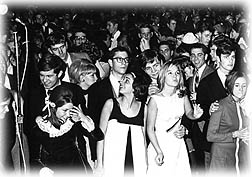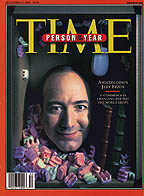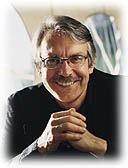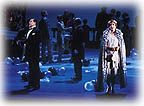Class Notes - January 26, 2000
Class notes features
From the Archives
 In this photograph taken at a dance in 1968, everyone seems to be having
a great time. Since Princeton wasn't coeducational at the time, women had
to travel from colleges and universities on the East Coast to party with
Princeton men. Perhaps one of our readers can identify some of the dancers
and give us details about the event.
In this photograph taken at a dance in 1968, everyone seems to be having
a great time. Since Princeton wasn't coeducational at the time, women had
to travel from colleges and universities on the East Coast to party with
Princeton men. Perhaps one of our readers can identify some of the dancers
and give us details about the event.
Jeff Bezos '86, king of cybercommerce
 Internet entrepreneur Jeff Bezos '86 joined a hallowed club of men and
women who have been named Time magazine's Person of the Year. The fourth
youngest to receive the honor, Bezos was selected in Time's December 27
issue for his role in ushering in the e-commerce revolution-the magazine
hailed him as "the man who is, unquestionably, king of cybercommerce."
In 1994 Bezos left a Wall Street career to sell books online, launching
the Seattle-based Amazon.com, the Web's largest retail store. By offering
his wares only online and by shipping from centralized locations, Bezos
began the dismantling of the world's traditional retail landscape. The company
has since expanded from just books to selling everything from power tools
to CDs and has also added auctions and an online flea market.
Internet entrepreneur Jeff Bezos '86 joined a hallowed club of men and
women who have been named Time magazine's Person of the Year. The fourth
youngest to receive the honor, Bezos was selected in Time's December 27
issue for his role in ushering in the e-commerce revolution-the magazine
hailed him as "the man who is, unquestionably, king of cybercommerce."
In 1994 Bezos left a Wall Street career to sell books online, launching
the Seattle-based Amazon.com, the Web's largest retail store. By offering
his wares only online and by shipping from centralized locations, Bezos
began the dismantling of the world's traditional retail landscape. The company
has since expanded from just books to selling everything from power tools
to CDs and has also added auctions and an online flea market.
Along with Bezos for his incredible adventure into e-commerce has been
his wife, MacKenzie '92, whom he married in 1993 and who is expecting the
couple's first child, a boy, in March.
Bezos is the third Princetonian to be named Time's Person of the Year.
John Foster Dulles '08 was selected in 1955 and John F. Kennedy '39 in 1962,
said Robert K. Durkee '69, vice-president for public affairs. By Durkee's
count, Bezos is among 30 Princetonians who have graced the cover of Time.
They include Adlai Stevenson '22, Lee Iacocca *46, George Shultz '42, Ralph
Nader '55, Brooke Shields '87, and Bill Bradley '65. (A complete list is
available on PAW's Website, www.princeton.edu/~PAW.)
Sing a song of Gatsby
John Harbison *63 renders F. Scott Fitzgerald's masterwork into opera
 December 20, 1999, marked the Metropolitan Opera debuts of two notable
Americans-John Harbison *63 and F. Scott Fitzgerald '17. Harbison, whose
honors include a 1987 Pulitzer Prize for his cantata The Flight into Egypt,
has adapted for opera The Great Gatsby, Fitzgerald's 1925 novel about aspiration
and disillusionment, romantic hope and moral failing, set against the landscape
of wealth and idle dissipation.
December 20, 1999, marked the Metropolitan Opera debuts of two notable
Americans-John Harbison *63 and F. Scott Fitzgerald '17. Harbison, whose
honors include a 1987 Pulitzer Prize for his cantata The Flight into Egypt,
has adapted for opera The Great Gatsby, Fitzgerald's 1925 novel about aspiration
and disillusionment, romantic hope and moral failing, set against the landscape
of wealth and idle dissipation.
Born in 1938, Harbison received an M.F.A. in music from Princeton, which
his father, a great-uncle, and two uncles had graduated from in the 1920s
and early '30s. Fitzgerald, of course, also attended Princeton, and his
description of it in his first novel, This Side of Paradise, remains singularly
evocative.
Harbison, an accomplished poet, spent two years preparing the libretto.
With the music, though, he faced one major stumbling block-music figures
significantly in the novel, which includes references to contemporaneous
songs and casts many descriptive passages in musical terms. Nick Carraway,
for example, describes his cousin Daisy Buchanan as possessing a "low,
thrilling voice (the kind of voice that the ear follows up and down as if
each speech is an arrangement of notes that will never occur again)."
Harbison knew that idiomatic music with idiomatic lyrics had to be woven
into the texture of the opera. This "popular" music needed to
resonate with Gatsby's world.
Initially, Harbison attempted to write the lyrics to the opera's popular
songs. "I found I didn't possess the specific skill for writing lyrics
to pop songs." Harbison and the Met approached lyricist Murray Horwitz,
coauthor of the Broadway musical Ain't Misbehavin'.
 Harbison provided Horwitz with a draft of the libretto and lead sheets
for the music to the songs. "I hoped Murray would pick up in the songs
the aura of the piece, and he did," says Harbison. "He gave me
words that fit the scenes very clearly."
Harbison provided Horwitz with a draft of the libretto and lead sheets
for the music to the songs. "I hoped Murray would pick up in the songs
the aura of the piece, and he did," says Harbison. "He gave me
words that fit the scenes very clearly."
Another consideration was the function of Nick Carraway, whose narration
gives the novel its rich psychological dimension. Harbison felt that a successful
opera treatment could not have Nick function as narrator. "Since much
of what Carraway says about people or describes is derived from him as a
witness, some of that text can move from the narrative to the characters.
I sought that which could be gathered from Nick's narration and put it into
the experience of the characters themselves."
Given this consideration, it was important for Harbison to sharpen the
focus of Gatsby's role. "A paradox of the novel is it has a very attractive
hero about whom almost all that is known is either false or hazy. That's
the fascinating part of Fitzgerald's conception but a challenge in musical
terms. Moreover, however unsympathetic some of the novel's characters may
be, as soon as they sing, one can no longer dismiss the poverty of their
ambitions quite so easily."
Harbison's The Great Gatsby is in two acts, with four scenes in the first
and six in the second. It follows closely the novel's chronology, with one
important exception: the element of foreshadowing is largely absent in the
opera.
Casting came early in the process of composition, and Harbison, who is
professor of music at the Massachusetts Institute of Technology, notes,
"It was important that we obtain a cast of singers-and we did-that
connected with the text. It was especially important that the role of Myrtle
be cast with a magnetic actress and singer. This might be surprising to
some people, but ultimately, there exists a relationship, though not explicit,
between Gatsby and Myrtle. She represents, in terms of romantic aspiration,
what Gatsby, obsessed with winning Daisy at all costs, wants and doesn't
know he should have." Linked to this aspiration is one of the novel's
central themes-what Harbison calls "the endless capacity for romantic,
irrational hope that is part of our national character, the inevitable mutability
and loss that overtake that hope."
Mario R. Mercado
Mario R. Mercado is an editor at Travel & Leisure magazine.This story
was adapted from one that originally appeared in Opera News.
GO TO
the Table of Contents of the current issue
GO TO
PAW's home page
PAW@princeton.edu
 In this photograph taken at a dance in 1968, everyone seems to be having
a great time. Since Princeton wasn't coeducational at the time, women had
to travel from colleges and universities on the East Coast to party with
Princeton men. Perhaps one of our readers can identify some of the dancers
and give us details about the event.
In this photograph taken at a dance in 1968, everyone seems to be having
a great time. Since Princeton wasn't coeducational at the time, women had
to travel from colleges and universities on the East Coast to party with
Princeton men. Perhaps one of our readers can identify some of the dancers
and give us details about the event. Internet entrepreneur Jeff Bezos '86 joined a hallowed club of men and
women who have been named Time magazine's Person of the Year. The fourth
youngest to receive the honor, Bezos was selected in Time's December 27
issue for his role in ushering in the e-commerce revolution-the magazine
hailed him as "the man who is, unquestionably, king of cybercommerce."
In 1994 Bezos left a Wall Street career to sell books online, launching
the Seattle-based Amazon.com, the Web's largest retail store. By offering
his wares only online and by shipping from centralized locations, Bezos
began the dismantling of the world's traditional retail landscape. The company
has since expanded from just books to selling everything from power tools
to CDs and has also added auctions and an online flea market.
Internet entrepreneur Jeff Bezos '86 joined a hallowed club of men and
women who have been named Time magazine's Person of the Year. The fourth
youngest to receive the honor, Bezos was selected in Time's December 27
issue for his role in ushering in the e-commerce revolution-the magazine
hailed him as "the man who is, unquestionably, king of cybercommerce."
In 1994 Bezos left a Wall Street career to sell books online, launching
the Seattle-based Amazon.com, the Web's largest retail store. By offering
his wares only online and by shipping from centralized locations, Bezos
began the dismantling of the world's traditional retail landscape. The company
has since expanded from just books to selling everything from power tools
to CDs and has also added auctions and an online flea market. December 20, 1999, marked the Metropolitan Opera debuts of two notable
Americans-John Harbison *63 and F. Scott Fitzgerald '17. Harbison, whose
honors include a 1987 Pulitzer Prize for his cantata The Flight into Egypt,
has adapted for opera The Great Gatsby, Fitzgerald's 1925 novel about aspiration
and disillusionment, romantic hope and moral failing, set against the landscape
of wealth and idle dissipation.
December 20, 1999, marked the Metropolitan Opera debuts of two notable
Americans-John Harbison *63 and F. Scott Fitzgerald '17. Harbison, whose
honors include a 1987 Pulitzer Prize for his cantata The Flight into Egypt,
has adapted for opera The Great Gatsby, Fitzgerald's 1925 novel about aspiration
and disillusionment, romantic hope and moral failing, set against the landscape
of wealth and idle dissipation. Harbison provided Horwitz with a draft of the libretto and lead sheets
for the music to the songs. "I hoped Murray would pick up in the songs
the aura of the piece, and he did," says Harbison. "He gave me
words that fit the scenes very clearly."
Harbison provided Horwitz with a draft of the libretto and lead sheets
for the music to the songs. "I hoped Murray would pick up in the songs
the aura of the piece, and he did," says Harbison. "He gave me
words that fit the scenes very clearly."